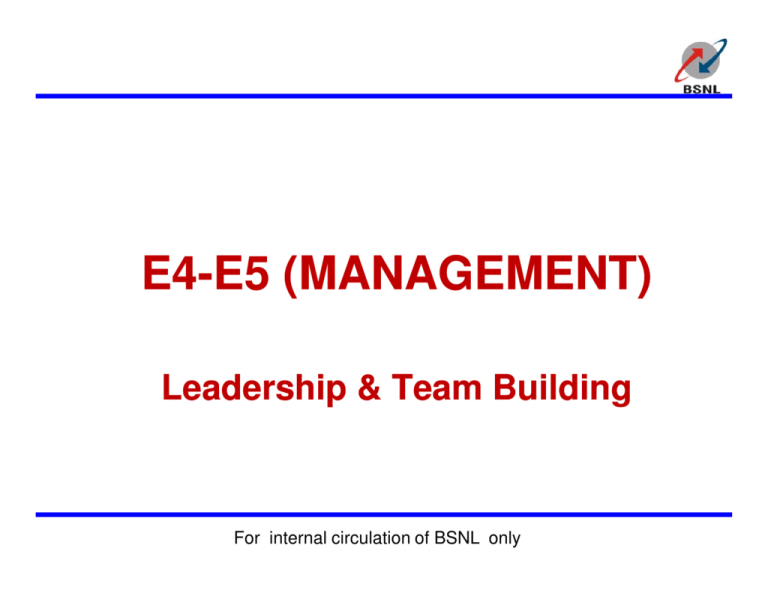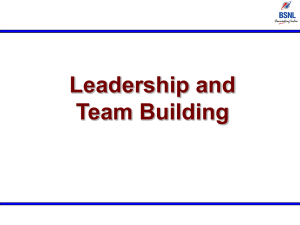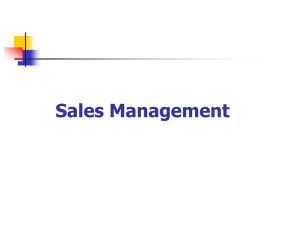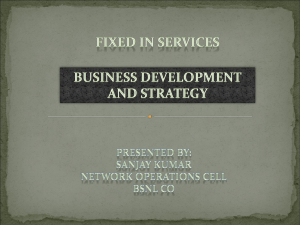Leadership & Team Building Presentation - BSNL
advertisement

E4--E5 (MANAGEMENT) E4 Leadership & Team Building For internal circulation of BSNL only Learning Objectives Leadership Fundamentals Understand.. why leadership is important the difference between Management v/s Leadership components of effective leadership leadership competencies leadership styles effective leaders skills functions of Leadership Leadership - Importance in Corporate Setup Business Environment Management of Change – Mapping Strategic Themes For internal circulation of BSNL only 2 Leadership Stakeholders CEO Executive Management Supervisory Employees Vision & Values Set Direction Develop Strategy Mission Performance Management Objectives Manage the Execution Perform Day to Day Activities Empowerment Challenge Principle based leadership Manage the business, Live the values, share the vision, Make others successful For internal circulation of BSNL only 3 Leadership Vision: Concerns to the future and refers to a dream or aspiration – preferred future state of organization Multidirectional, Broad beamed, People oriented Appeal to emotions and inspires others Mission: refers to the organization's ultimate purpose or primary goals What the organization stands for; relates to the present and is related to the core competency of the organization. Missions are time bound and Specific What and When== What we are going to do and by when? == Mission Statement Strategy: refers to the ‘how’ or the process through which the mission is to be accomplished. For internal circulation of BSNL only 4 Why Leadership – Important? Business Environment ? Increasing competition –challenge from competitors New pattern of organization- Horizontal organization, more outsourcing Shift in the balance power from employer to employee- leader has a vital role to play in keeping employees aligned and motivated Need for commitment based organisation In Environment of change, the leader has clear role to play to ensure continued organisational health: defining the need for change and influencing others to see the need describing the future state the organization must achieve people must know the work that needs to be done to achieve the future state. For internal circulation of BSNL only 5 Leadership Fundamentals What is leadership? The literature on leadership has more than 350 definitions of the word .. “ its essential nature is the ability to get the best out of people”. Lord Moran- “Leadership is the capacity to frame plans which will succeed & and the faculty to persuade others to carry them out in the face of all difficulties”. Stanford research institute- Implementation of plan by persuading others counts for 88% of strategic management. • knowing what to do + GETTING THINGS DONE • capability + EFFECTIVENESS For internal circulation of BSNL only 6 Leadership Fundamentals Management v/s Leadership! John Kotter – Management is about dealing with complexity, while leadership is about dealing with change While management is concerned with planning and budgeting, organizing and staffing and controlling and problem-solving the leader operates outside this logistical world, and concentrates on setting a direction for the organization, communicating this to people and aligning them behind his or her vision, and motivating and inspiring them to continue on the same path. Both management and leadership are needed of course, but leadership seems to be becoming more necessary. Why is this? For internal circulation of BSNL only 7 Leadership Fundamentals Management v/s Leadership! Person who decides what shall be done is called Manager Keith Davis defines leadership as the ability to persuade others to seek defined objective enthusiastically P. Hersey and K. Blanchard point out that a Manager can be successful but ineffective ….. Management is the accountability that we have to formulate and achieve the objectives of the organization Leadership is the responsibility we have to represent our followers’ need and help them achieve the organizational goals. The manager-ship – leadership dichotomy is reciprocal relationship: the more you choice to manage, the less you choose to lead. For internal circulation of BSNL only 8 Effective leadership – 3 distinct elements 1. Setting and communicating a direction Need a thorough knowledge of the organization and its capabilities have a thorough knowledge of current and potential market Be a role model for others Be clear about what you want 2. Aligning people To make vision a reality, we need the dedication and commitment of people Aligning people means soliciting the commitment, support or guidance If the vision is not shared, it is ineffective-create a shared vision For internal circulation of BSNL only 9 Effective leadership – 3 distinct elements 3. Implementation Exemplify stability Being committed to the development of others Managing individuals’ performance effectively Making sure that good performance is acknowledged Effective leader are skilled in the following areas: Creating a vision Gaining commitment to vision Ensuring execution For internal circulation of BSNL only 10 Leadership Competencies Vision Knowledge and Skill : Professional Competencies Experience and learning Team Building ability Conflict resolution skill Decision making ability Ability to involve employees Character- selflessness Clear sense of direction For internal circulation of BSNL only 11 Leadership Framework You must: BE • A professional, Seek responsibility and take responsibility for your actions • Searching ways to guide your people • With Good Character Traits – competency, commitment, integrity, courage and imagination KNOW • Know yourself – understand your BE, KNOW and DO • and seek self improvement – improve your attributes: self study, reading and practicing good behavior • Your Job, Human Nature, Your Organization DO • Provide direction • Implement • Motivate For internal circulation of BSNL only 12 of handling people Initiative to be a self starter Selflessness based on Ideal or Vision of the Job of self Will Power to Persist Courage to decide For internal circulation of BSNL only CHARACTER Knowledge Universal Inner Structure of Good Leader Faith in God, Integrity, Honesty Loyalty, Sincerity 13 Universal Inner Structure of Good Leader The understanding of Universal Inner Structure of Effective Leaders can be used to improve own potential, encourage and groom others to become effective leaders …..It is possible to improve one’s character if one is prepared to make an effort Self development of the effective executive is central to development of an organization As executives work towards becoming effective they raise the performance level of others and organization as well Self development really means developing leadership – modest yet enduring leadership of dedication, determination and serious purpose. For internal circulation of BSNL only 14 Leadership - Power Power: A person has the potential for influencing five points of power over others Coercive Power Reward Power Legitimate Power Expert Power Referent Power Power verses Leadership • Power does not require goal compatibility, leadership requires goal congruence • Power focuses for gaining compliance, leadership focuses on getting solutions For internal circulation of BSNL only 15 Leadership Styles Leadership style is the manner and approach of providing direction, implementing plans, and motivating people. 1. Autocratic- Leader tells employees what he wants done and how he wants it done, without getting the advice of his team. 2. Participative- This type of style involves the leader including one or more employees in the decision making process (determining what to do and how to do) . The leader maintains the final decision making authority 3. Delegative (free- reign) -The leader allows the employees to make the decision. For internal circulation of BSNL only 16 Low Relationship Behavior High Leadership Styles - Effective Leadership Style High Relationship & Low Task Q3 High Task Q2 & High Relationship Participating Selling Low Task Q4 & Low Relationship High Task Q1 & Low Relationship Delegating Telling Low Task Behavior Range of appropriate leadership styles for different maturity levels High Mature M4 M3 M2 M1 Immature Maturity of Follower For internal circulation of BSNL only 17 Functions of leadership Function for Task Needs Task Needs Individual Needs Group Maintenance Needs Function for individuals needs Defining the task Making the plan Allocating work & resources Controlling quality & tempo of work Checking performance against the plansfor Group needs Function Setting standards-example Maintaining discipline Building team spirit Encouraging, motivating, giving a sense of purpose Appointing sub-leaders Attending to personal problems Ensuring communication within the group Praising of individuals Training the group Knowing individuals personally Recognizing and using individual abilities Training individuals For internal circulation of BSNL only 18 Team Building Defining today’s Teams What is Team Building? Key components of an effect team Role of an effective team leader Critical Team variables Strategies for team building & Team development For internal circulation of BSNL only 19 Team Building Team building a popular tool for workplace management: concept emerged because of an awareness of the following ideas. Involvement is a precondition to commitment Management should act like team leaders and coaches. Work groups have the necessary capacity to cope with their own problems provided they are aware of their capacity and problems. Employees are innately cooperative and self-actualising, preferring the chance to exercise a degree of control over their work environment. Emphasis on interpersonal trust, openness, and self- disclosure. Effective team key to business success because: •Change is managed better •Customers’ needs are more effectively met. •Competitive advantage is more easily gained. For internal circulation of BSNL only 20 Team Building What is a team? •A team is a group of people with a high degree of interdependence focused on the achievement of some goal of task. •Three key ideas on team: • Each team member has a common purpose, mission or goals. •The members are interdependent(that they need each other to achieve their purpose) •They agree they must work together effectively to achieve their goal. •Effective Team: Is capable of accomplishing much more than the sum total of what the members are capable of accomplishing individually. •Synergy •1+1+1+1+1+=6 or 7 or 8! •Effective team adds value & generates synergy. For internal circulation of BSNL only 21 Key components of an effect team Enthusiasm Energy Hummer and Fun Focus and Persistence Thinks and Plans Supportive Decisive Shares information Internally and Externally For internal circulation of BSNL only 22 Key components of an effect team Listening Questioning Learning from Mistakes Open and Honest Clear Roles Effective Team Involvement Flexible Clear, Shared Purpose and Direction Feedback and Review For internal circulation of BSNL only Commitment 23 What An Effective Team Leader Does ? 1. Ensures: Quality decision making Proper balance between planning and action Technical competence to complete the tasks A flow of good ideas The team does not close in on itself Each individual has a clear role Team-members are involved and participate There is a clear sense of direction and purpose 2. Avoids: 3. Allows: Excessive focus on detail Hidden agendas and Mistakes Challenge within the supportive environment Flexibility of approach For internal circulation of BSNL only 24 What An Effective Team Leader Does? 4. Develops Review and feedback mechanisms Good Listening skills A focus on achieving the task 5. Shares: Information 6. Generates: Commitment and support 7. Encourages: Humour Produces Powerful Performance For internal circulation of BSNL only 25 Effective Team! Team Effectiveness Effective Team may be defined as one that achieves its specific aim in the most efficient way with the optimal utilization of resources and shortest time. The team output is more than the aggregation of individuals’ inputs. Effective team adopts aggressive or defensive postures depending on the requirement of the situation. Effective team make the best use of individual strengths and shield members from individual exposure Effective teams agree Vision, Mission and strategy. Effective teams become self managing units. They need freedom to breath For internal circulation of BSNL only 26 Critical Team variables Vision, Mission and Process Task Group Individual Effective Team Leader: Helps the group develop the Vision, Mission Processes are agreed and Implemented Alignment Commitment For internal circulation of BSNL only 27 Strategies for Team Building Leader to believe in teams and in the potential of each team member. Get to know the team members, identify their strengths and focus on individual strengths to build team performance. Try to stop criticism in the team early on, but encourage feedback when the team has developed some cohesion. Ensure there are regular meetings of the team without interruptions. For internal circulation of BSNL only 28 Strategies for Team Building Create an environment where team members become more empathetic and where there can be constructive debate------’ anyone can voice an opinion”. Not to try to control the people but the processes which build the team. Involving members, role clarity, ground rules for meeting, gaining agreements, consistent control as per agreed rules. For internal circulation of BSNL only 29 Learning Points Introspect Universal Inner Structure of Good Leaders – make a determined efforts to practice what you felt is good Leadership particularly its major component – EFFECTIVENESS can not be taught It can be acquired only by self efforts Peter Drucker asserts that effectiveness can be learnt – practising – practising again “ Try, try again”……………..Poem of Robert Bruce. “Never, Never, Never Give up” – 5 words of Winston Churchil In the context of BSNL, we see managing change is a big challenge, competition, customer expectations and employees expectations are increasing continually. Leadership & Team Building at every level is becoming more and more important to progress in the path of managing change and meeting the expectations. For internal circulation of BSNL only 30 For internal circulation of BSNL only 31




